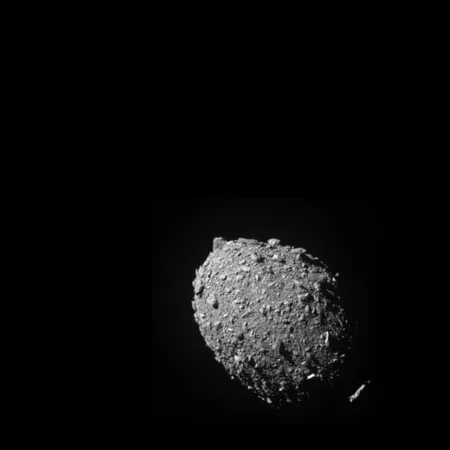
Hera Mission Set to Uncover Secrets of Asteroid Deflection
2024-10-04
The Hera Mission Launch
The groundbreaking Hera spacecraft, developed by the European Space Agency (ESA), is gearing up for its anticipated launch on Monday. This remarkable mission aims to investigate the aftermath of a groundbreaking experiment conducted by NASA that involved crashing a spacecraft into the asteroid Dimorphos as part of a planetary defense test, marking a significant leap in humanity's ability to protect Earth from potential asteroid threats.
NASA's DART Experiment
In a dramatic event reminiscent of science fiction, NASA's Double Asteroid Redirection Test (DART) deliberately collided with the pyramid-sized Dimorphos in September 2022. This event occurred approximately 11 million kilometers (6.8 million miles) away from Earth and successfully altered the asteroid’s trajectory, proving that humanity can indeed redirect asteroids.
The Purpose of the Hera Mission
Despite the success of DART, a myriad of questions linger regarding the extent of the damage inflicted on Dimorphos and its original composition. To illuminate these mysteries, the ESA has initiated the Hera mission — essentially a “crime scene investigation” — aimed at evaluating how we can enhance Earth’s defenses against hazardous asteroids.
Launch Details and Timeline
The Hera spacecraft is slated to be launched aboard a SpaceX Falcon 9 rocket from Cape Canaveral, Florida. However, potential delays loom due to an anomaly that was noted during the recent launch of SpaceX’s Crew-9 mission. ESA's Hera project manager, Ian Carnelli, reported that they are awaiting approval from the U.S. Federal Aviation Administration, NASA, and SpaceX by Sunday, and the launch window extends until October 27.
Mission Path and Goals
Once launched, Hera is planned to fly past Mars in 2024 before reaching Dimorphos in December 2026, where it will embark on an intensive six-month investigation. The mission is particularly crucial, as even small asteroids carry the potential to cause catastrophic events, reminiscent of the asteroid thought to have contributed to the extinction of dinosaurs.
Asteroid Impact Statistics
Asteroid impacts are remarkably rare, with an object larger than a kilometer (about 0.6 miles) striking Earth only every 500,000 years on average. However, more accessible threats exist, such as asteroids around 140 meters (460 feet) wide, which could devastate major cities and occur about every 20,000 years. Although numerous asteroids reside in the main belt between Mars and Jupiter, most larger than one kilometer are accounted for, and there are currently no imminent threats detected.
Insights from DART's Impact
The Hera mission’s principal investigator, Patrick Michel, emphasized the knowledge we’ve gained in planetary defense, stating that humanity now possesses the tools to shield ourselves from asteroid impacts. Following DART's successful impact, analysis revealed that Dimorphos, which orbits its larger counterpart Didymos, is not a robust mass but rather a loose conglomeration of rubble held together by gravity. This unexpected finding indicates that instead of creating a crater, DART may have deformed Dimorphos, leading to intriguing possibilities for how such low-gravity objects behave, an area still shrouded in uncertainty.
Scientific Instruments on Hera
The impressive 363 million-euro ($400 million) Hera mission will be outfitted with 12 scientific instruments, including two nanosatellites. The Juventas nanosatellite intends to make history by attempting to land on the small asteroid, utilizing radar technology to examine its interior and a gravimeter to measure its gravitational pull. Meanwhile, the Milani nanosatellite will observe the asteroid's composition from a distance, utilizing cameras and other tools to analyze the consequences of DART’s impact.
The Future of the Hera Mission
Once Hera has conducted its mission, the ultimate goal is for it to harmoniously settle onto the surface of Dimorphos or Didymos, where it may remain as a lasting monument to humanity’s quest to understand and protect our planet from celestial threats. Prepare for a journey into the unknown that could redefine our defenses against cosmic dangers lurking in the dark void of space!



 Brasil (PT)
Brasil (PT)
 Canada (EN)
Canada (EN)
 Chile (ES)
Chile (ES)
 España (ES)
España (ES)
 France (FR)
France (FR)
 Hong Kong (EN)
Hong Kong (EN)
 Italia (IT)
Italia (IT)
 日本 (JA)
日本 (JA)
 Magyarország (HU)
Magyarország (HU)
 Norge (NO)
Norge (NO)
 Polska (PL)
Polska (PL)
 Schweiz (DE)
Schweiz (DE)
 Singapore (EN)
Singapore (EN)
 Sverige (SV)
Sverige (SV)
 Suomi (FI)
Suomi (FI)
 Türkiye (TR)
Türkiye (TR)